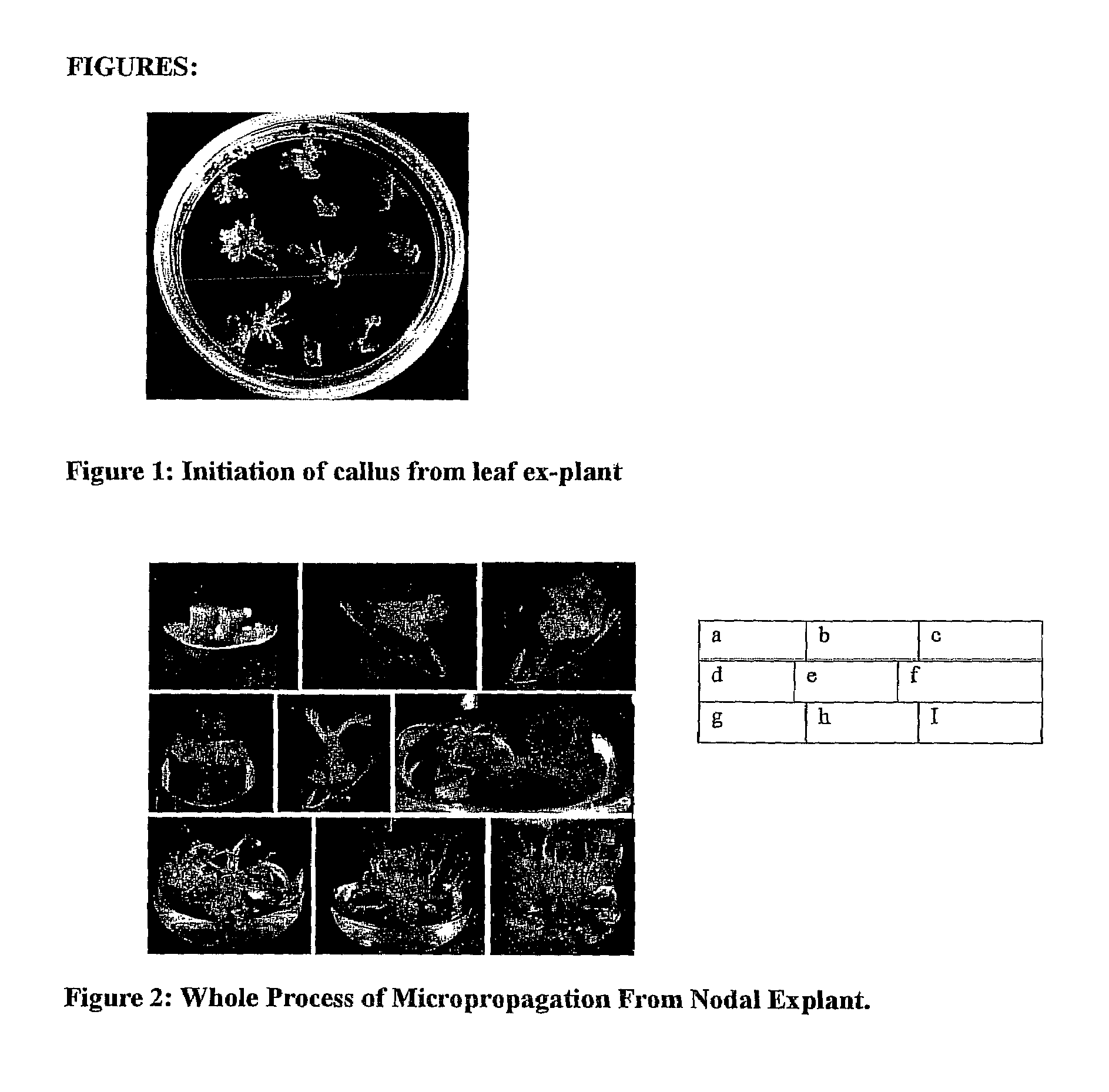In-vitro system of micropropagation of rose scented pelargonium graveolens, of bourbon type
a technology of pelargonium graveolens and in-vitro system, which is applied in the field of high-efficiency invitro system of micropropagation of rose scented pelargonium graveolens, can solve the problems of systemic pathogens getting propagated, relatively low number of plant multiplication, and reduced vigor of plant multiplication, etc., to achieve low cost of production and low cost. , the effect of reducing the number of plant multi
- Summary
- Abstract
- Description
- Claims
- Application Information
AI Technical Summary
Benefits of technology
Problems solved by technology
Method used
Image
Examples
example 1
Identification of Explant:
[0091]According to the present invention to identify the explant with best regeneration and multiplication capacity, following experiment was conducted,
[0092]Various explants namely leaf, stem, petiole and nodal segment were excised from the rose scented geranium Pelargonium graveolens L. Herit of Bourbon or Reunion type plants growing in controlled environment in the green house at least for period of 4 months. The explants were cleaned by washing with mild detergent like Tween-20 0.1% for 5 minutes, followed by washing with distilled water. In order to remove the fungus or bacterial contaminants from the surface of the explants they were washed with disinfectant solution containing systemic fungicide bavistin 0.1%, contact fungicide Indofil M-45 0.1%, systemic insecticide Fenualerate 0.1% and after each wash they were rinsed with distilled water to remove fungicide and insecticide. The explants were surface sterilized by treating the explant under laminar...
example 2
[0093]Nodal region explants were collected from rose scented geranium Pelargonium graveolens L. Herit of Bourbon or Reunion type growing in controlled environment in the green house at least for period of 4 months. Nodal explants were washed with distilled water, followed by 0.1% of Tween-20 for 5 minutes and final wash with distilled water. The explants were treated with a disinfectant solution comprising bavistin 0.1%, Indofil M-45 0.1% and Nuvacron 0.1%, for 10 minutes and repeatedly washed with sterilized distilled water each lasting for 5 minutes.
[0094]The explants were then sterilized under laminar flow with 0.01% mercuric chloride for five minutes, followed by washing with sterilized distilled water for 5 times each lasting for 5 minutes to ensure that there is no residual left over of mercuric chloride on the surface of explants. Nodal explants were cut with the help of sterilized scalpel into size of about 5 mm under laminar flow, after dipping into sterilized water, with t...
example 3
[0100]Micropropagation of rose scented geranium Pelargonium graveolens L. Herit of Bourbon or Reunion type was carried out as per the method illustrated in example 2, as a whole, except for the medium for shoot regeneration and multiplication, wherein the composition contained MS medium modified to have 400 mg per liter of inositol, 7 mg per liter of kinetin and 1 mg per liter of Naphthalene acetic acid.
PUM
 Login to View More
Login to View More Abstract
Description
Claims
Application Information
 Login to View More
Login to View More - R&D
- Intellectual Property
- Life Sciences
- Materials
- Tech Scout
- Unparalleled Data Quality
- Higher Quality Content
- 60% Fewer Hallucinations
Browse by: Latest US Patents, China's latest patents, Technical Efficacy Thesaurus, Application Domain, Technology Topic, Popular Technical Reports.
© 2025 PatSnap. All rights reserved.Legal|Privacy policy|Modern Slavery Act Transparency Statement|Sitemap|About US| Contact US: help@patsnap.com

